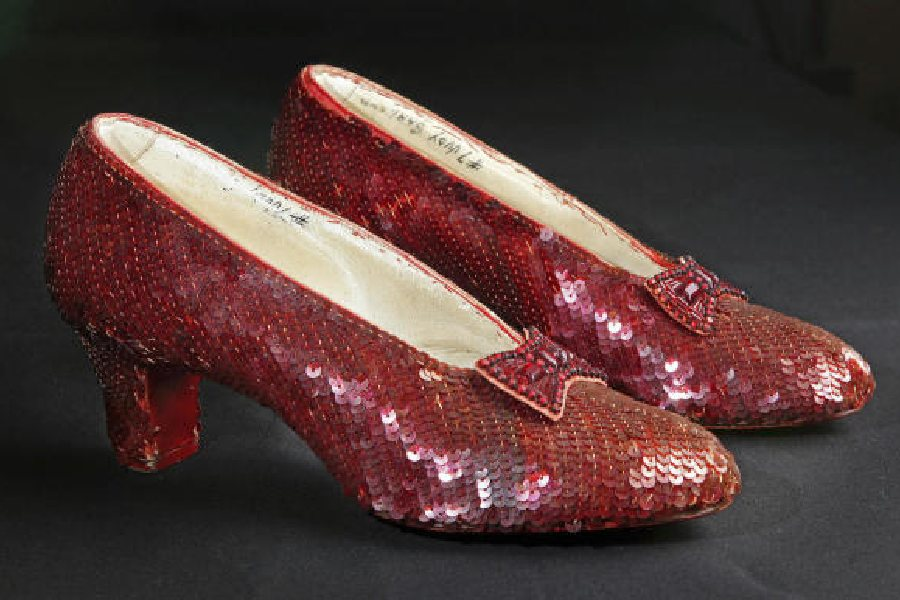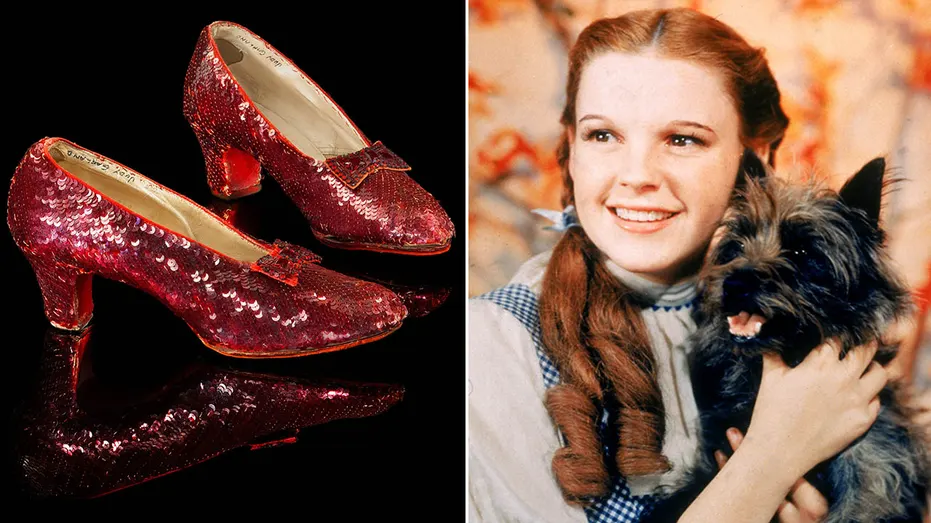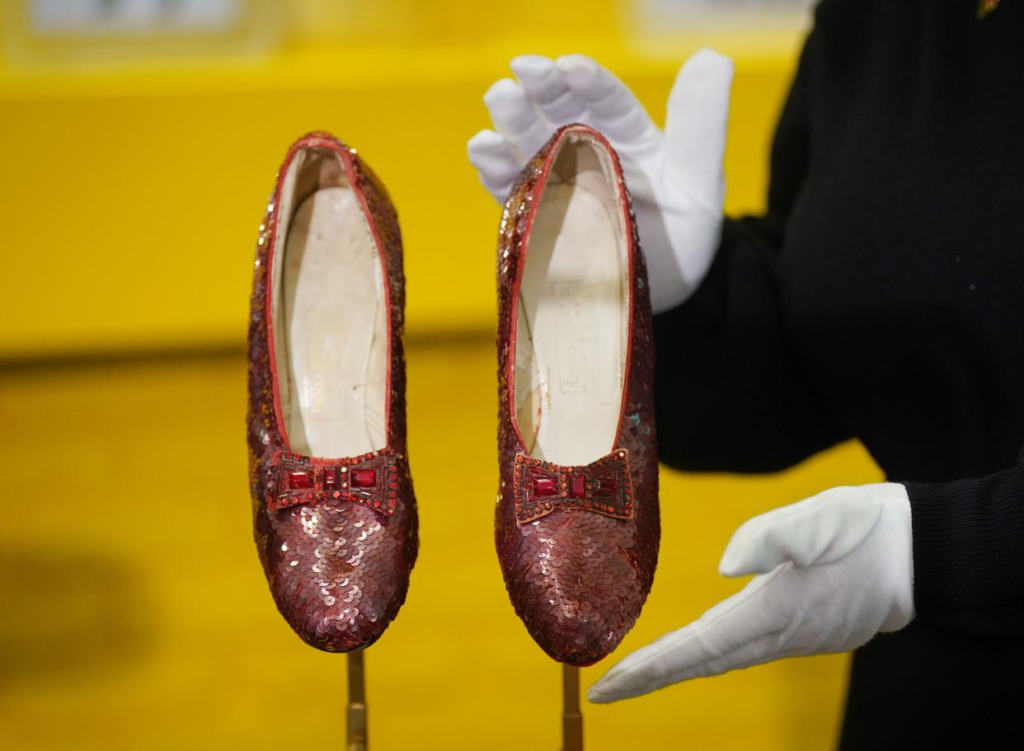The iconic ruby slippers worn by Judy Garland in the 1939 classic The Wizard of Oz have made history once again, fetching an astounding $28 million at auction, plus $4.5 million in fees, bringing the total to $32.5 million.
These slippers, steeped in cinematic legacy, are one of the four surviving pairs used in the film. Their journey, however, is more than just a story of glamour; it is a tale of theft, recovery, and their indelible mark on Hollywood history.
The Legacy of the Ruby Slippers
Few items in Hollywood’s history are as instantly recognizable as the ruby slippers. Designed by MGM’s legendary costume designer Adrian Greenberg, the slippers embodied the fantasy and magic of Dorothy Gale’s journey down the Yellow Brick Road.
Made with sequins and dyed red for the film, the shoes were more than a prop—they became a symbol of hope, perseverance, and the longing for home.
From the moment The Wizard of Oz premiered, the ruby slippers captured the public’s imagination. Judy Garland’s portrayal of Dorothy Gale brought a heartfelt charm to the story, and her magical shoes became an integral part of her iconic image.
Read : 1955 Mercedes-Benz 300 SLR Became World’s Most Expensive Car to Be Auctioned
Decades after the film’s release, these slippers remain deeply ingrained in pop culture, inspiring countless replicas, tributes, and even a dedicated fan following.
Read : 161-Million-Year-Old World’s Largest Stegosaurus Skeleton Put on Auction in New York
Over the years, the slippers have been highly sought-after collectibles, appearing in various auctions and exhibitions. The rarity of the original pairs has only heightened their allure.

In 2000, one pair sold for $666,000. In 2012, another pair was purchased by Steven Spielberg and Leonardo DiCaprio for $2 million and later donated to the Academy Museum of Motion Pictures in Los Angeles. However, the pair that just sold stands out not only for its record-breaking price but also for its dramatic history.
The Theft and Recovery: A Dramatic Journey
The journey of this particular pair of ruby slippers is nothing short of extraordinary. In 2005, they were stolen from the Judy Garland Museum in Grand Rapids, Minnesota.
The heist was executed by Terry Jon Martin, who used a hammer to break into the glass display case and steal the shoes. At the time, the slippers were on loan to the museum by Michael Shaw, a private collector.
The theft devastated fans and curators alike, leaving a gaping void in the museum’s collection. For over a decade, the slippers’ whereabouts remained a mystery, with law enforcement struggling to trace the stolen artifact. Rumors swirled about their fate—some speculated they had been destroyed, while others believed they were hidden in an unknown location.
In 2018, the FBI received a tip that led to a sting operation and the recovery of the stolen slippers. To confirm their authenticity, the shoes were cross-referenced with another pair housed at the Smithsonian Institution.
It was discovered that at some point, the pairs had been swapped, with each containing one shoe from two different original pairs. This only added to the intrigue surrounding the slippers.
Once verified, the slippers were returned to their rightful owner, Michael Shaw, earlier this year. Shaw subsequently entrusted them to Heritage Auctions for the record-breaking sale, ensuring the shoes would find a new home while preserving their historical significance.
The Auction and Cultural Impact
On the auction block, the ruby slippers generated immense excitement and fierce bidding. Heritage Auctions reported that the live bidding began at $1.55 million and soared past $3 million within seconds.

By the end, the winning bid reached $28 million, with the buyer paying additional fees, bringing the total to $32.5 million. This made the slippers the most valuable movie memorabilia ever sold at auction.
The auction also broke records for entertainment memorabilia, with the total sale reaching nearly $40 million. Alongside the ruby slippers, other notable items included the Wicked Witch’s hat from The Wizard of Oz, which sold for $2.9 million.
Among the bidders was the Judy Garland Museum, which had launched a campaign to reclaim the slippers for display in Garland’s birthplace of Grand Rapids, Minnesota.
The museum received support from the city and state lawmakers, including $100,000 in funding from Minnesota legislators. Despite their efforts, the museum was ultimately outbid, expressing their disappointment in a heartfelt statement.
The staggering price of the ruby slippers underscores their enduring cultural significance. For many, they represent a nostalgic connection to one of the greatest films of all time. Their sale not only highlights their value as a collectible but also cements their place in the annals of cinematic history.
A Symbol of Hollywood’s Golden Age
The ruby slippers are more than just an artifact; they are a tangible link to Hollywood’s golden age. The Wizard of Oz, released in 1939, was a groundbreaking film that combined Technicolor, imaginative storytelling, and unforgettable music. Judy Garland’s performance and the magic of the ruby slippers helped make the movie a timeless classic.

The film’s themes of home, courage, and self-discovery resonate with audiences to this day. The ruby slippers, as a central motif in the story, have become a powerful symbol of those ideals. Their presence in pop culture extends far beyond the movie itself, appearing in parodies, art, and even political discourse.
The sale of these slippers serves as a reminder of the enduring power of cinema. They encapsulate a moment in time when Hollywood created not just movies but dreams. For collectors and fans alike, owning a piece of that history is priceless, as evidenced by the extraordinary price these slippers commanded.
As the most expensive piece of movie memorabilia ever sold, the ruby slippers reaffirm the lasting legacy of Judy Garland and The Wizard of Oz. Whether displayed in a private collection or loaned to a museum, their story will continue to inspire and captivate future generations.
let’s enjoy few years on earth with peace and happiness….✍🏼🙏

